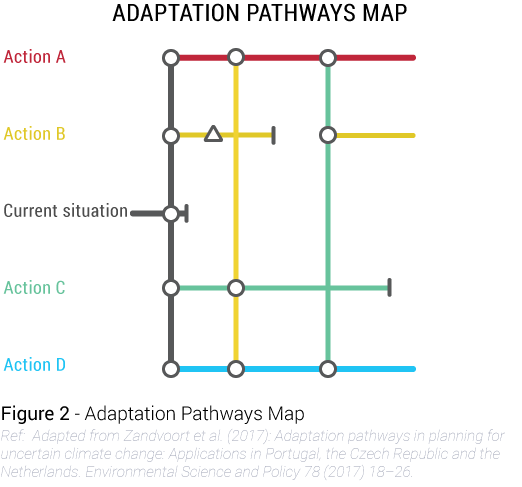
What are adaptation pathways and how to create them?
Download playbookWhat do we mean by transformational adaptation?
Coping with climate change can take the form of many strategies. For instance, in response to floods a community could build higher dams or offer preferential loan conditions to rebuild damaged homes. However, these actions don’t fundamentally change the risk of increasingly severe storms or future floods. There is also a socio-economic limit to these measures which prevents them from being implemented indefinitely. Instead of these “incremental adaptations”, communities could envisage to respond to these uncertain risks by transforming their social-ecological system into a more resilient one. This could mean the relocation of houses or crop fields to different areas, or any other measure that fundamentally alters the system’s ecological and social properties. This reduces the root causes of the vulnerability to climate change. Since these transformative adaptation measures are much more far-reaching and invasive, the implementation can face quite a few barriers in terms of social or political support. This is where the co-creation and engagement of stakeholders becomes very important to facilitate and co-develop adaptation pathways that are supported and accepted by the local community.

Action A&D: Robust action but require large capital or would have ramifications on social/economic systems. (e.g. elevating roads/houses).
Action B: Short term action - easily implemented/allow to buy us time but do not have a long shelf life. (e.g. installation of booster pumps to improve drainage capacity).
Action C: Medium term action
How to construct adaptation pathways?
The practical implementation of transformational adaptation can thus take the form of adaptation pathways. These can be described as sequences of actions, which can be implemented progressively depending on future dynamics. An important aspect here is that it addresses one of the major issues faced by decision makers when it comes to climate change, namely uncertainty. The objective is to make an assessment of different solutions, calculate their feasibility, and mark decision nodes or tipping points where one pathway can take effect or be engaged. Adaptation pathways can thus encompass alternative ways to achieve a defined objective or strategic outcome. This webtool and the playbook will attempt to convey the necessary tools to develop and envision these adaptation pathways for a wide variety of community systems.

